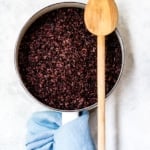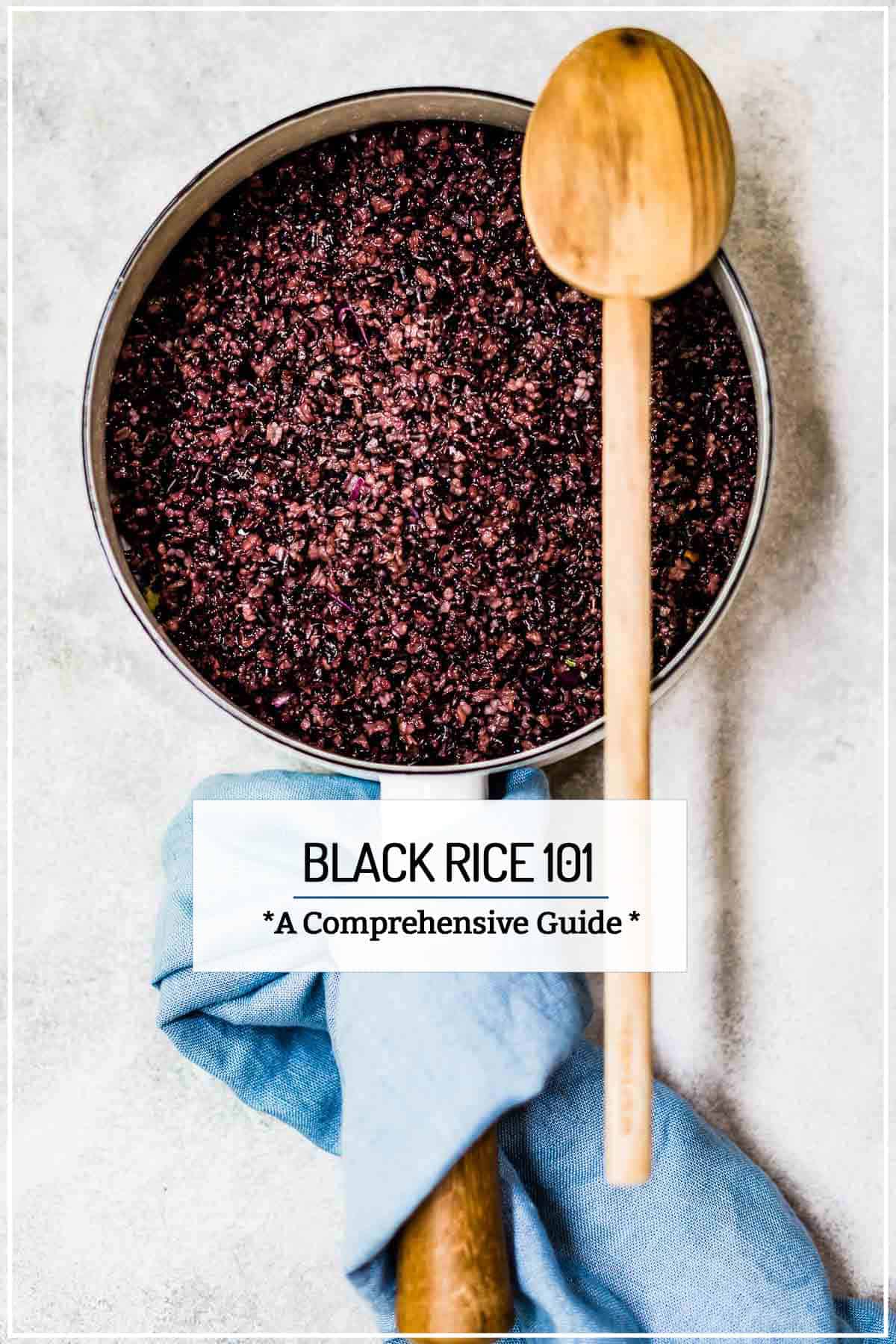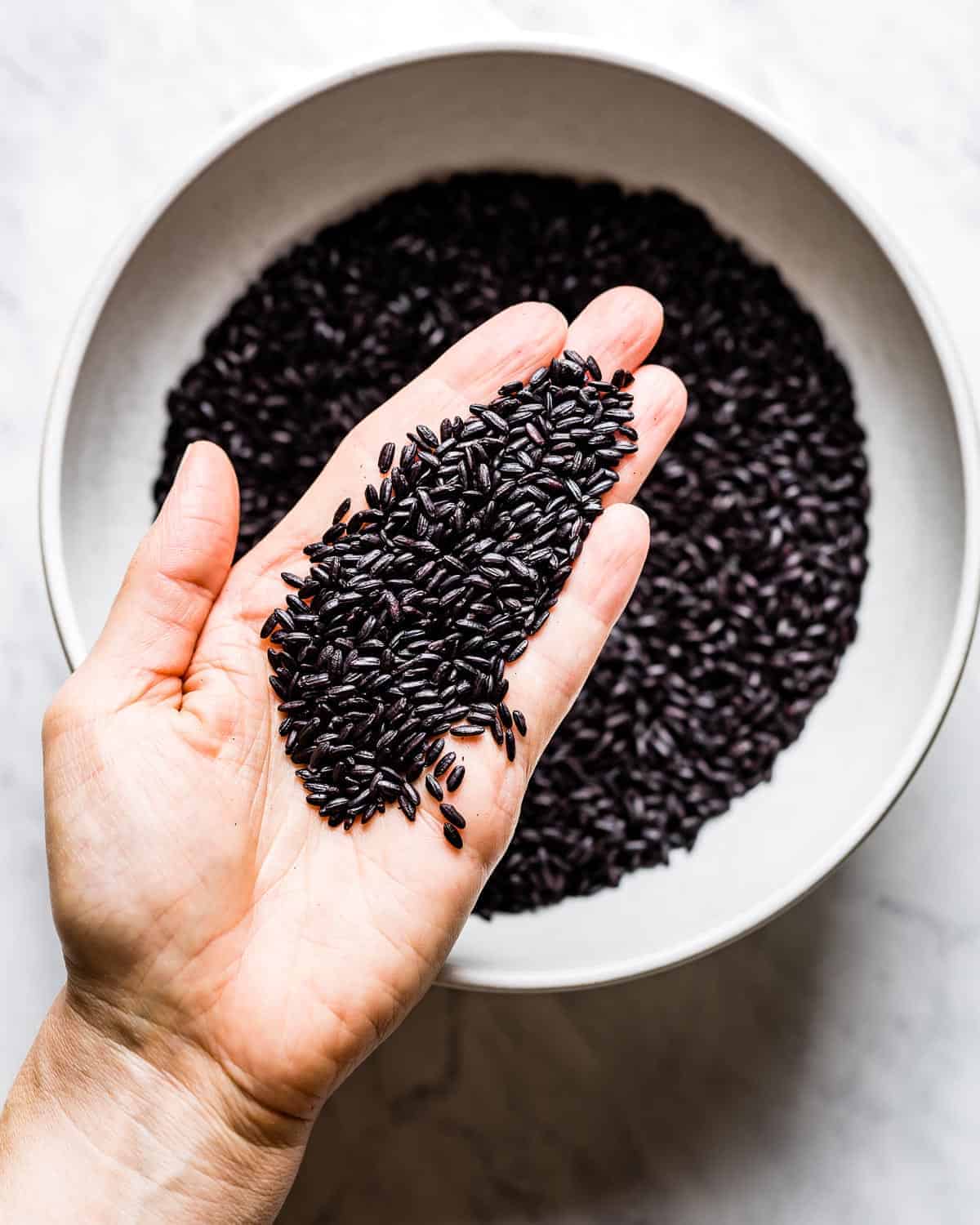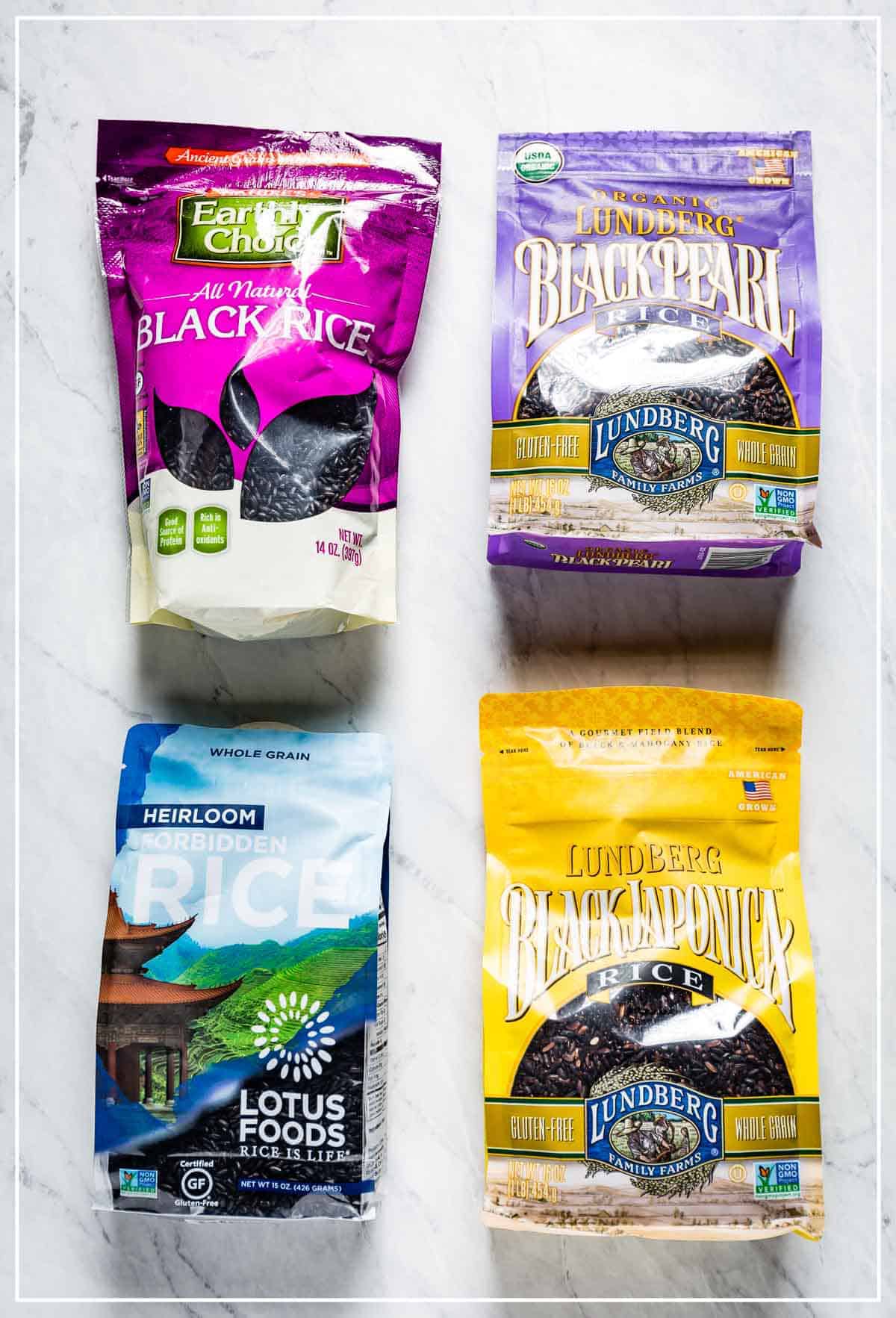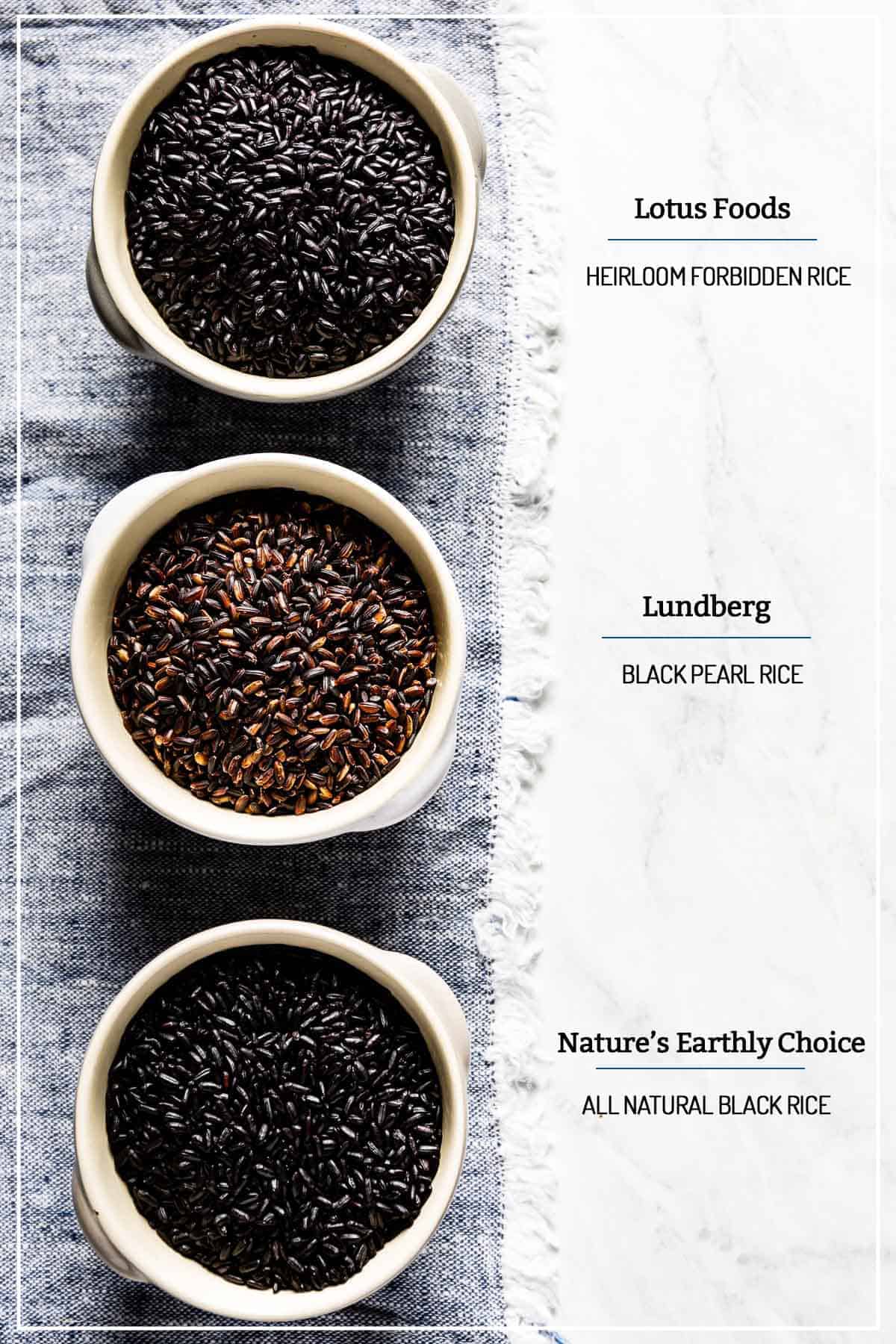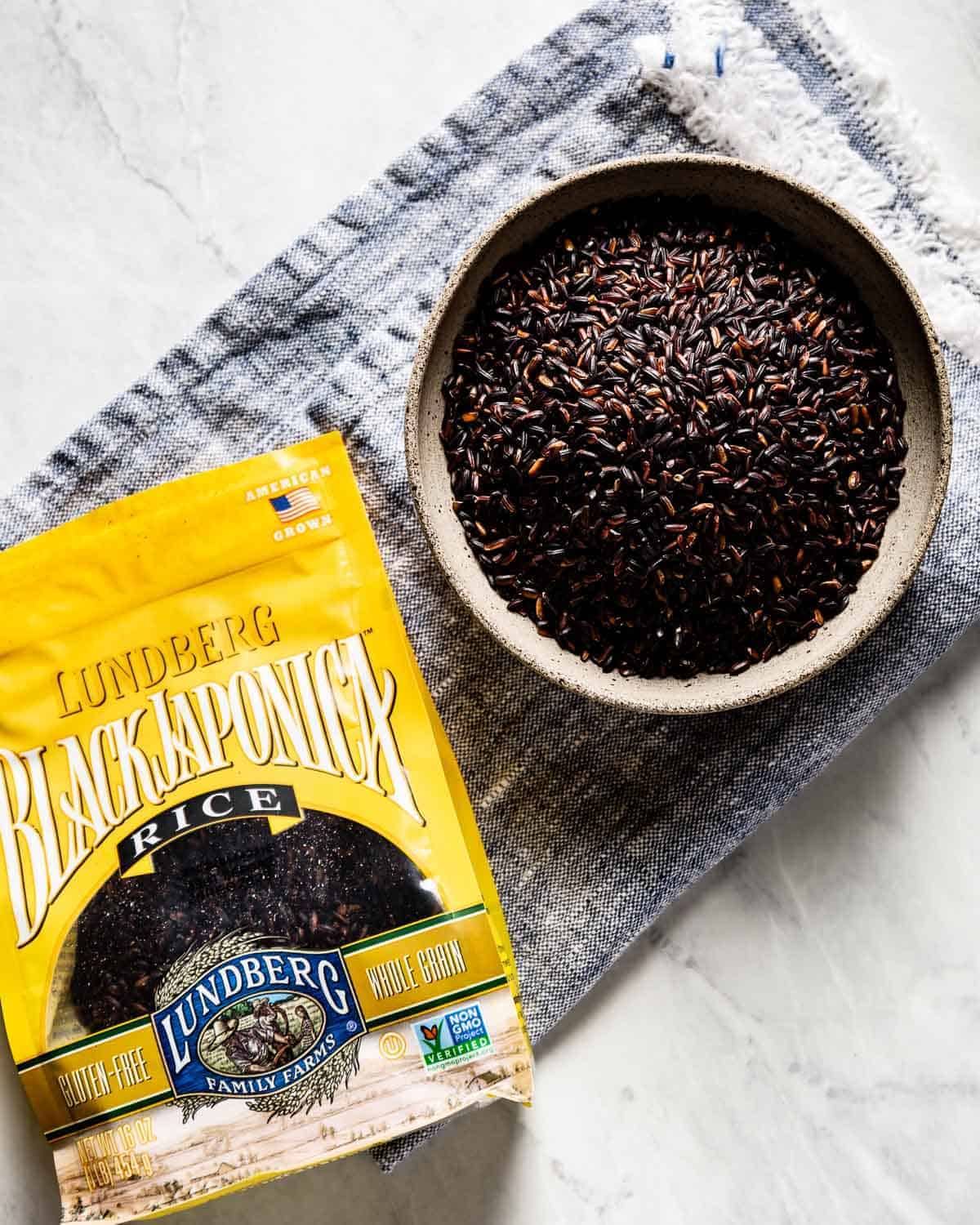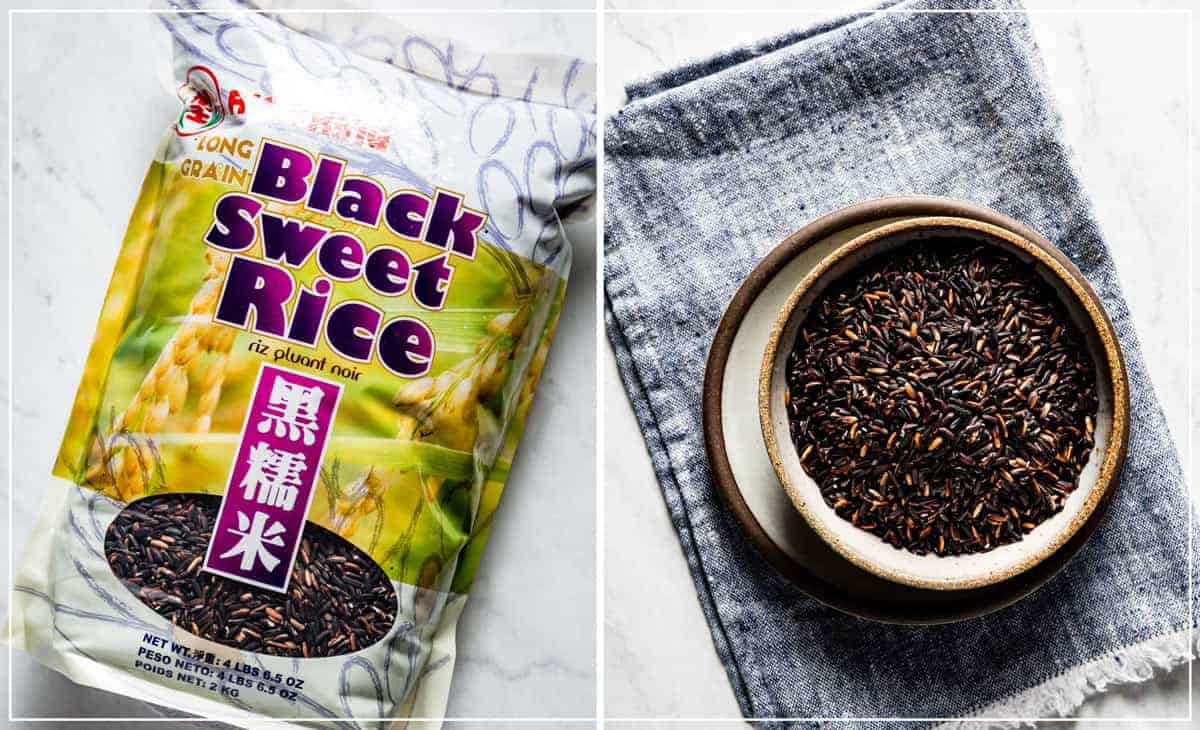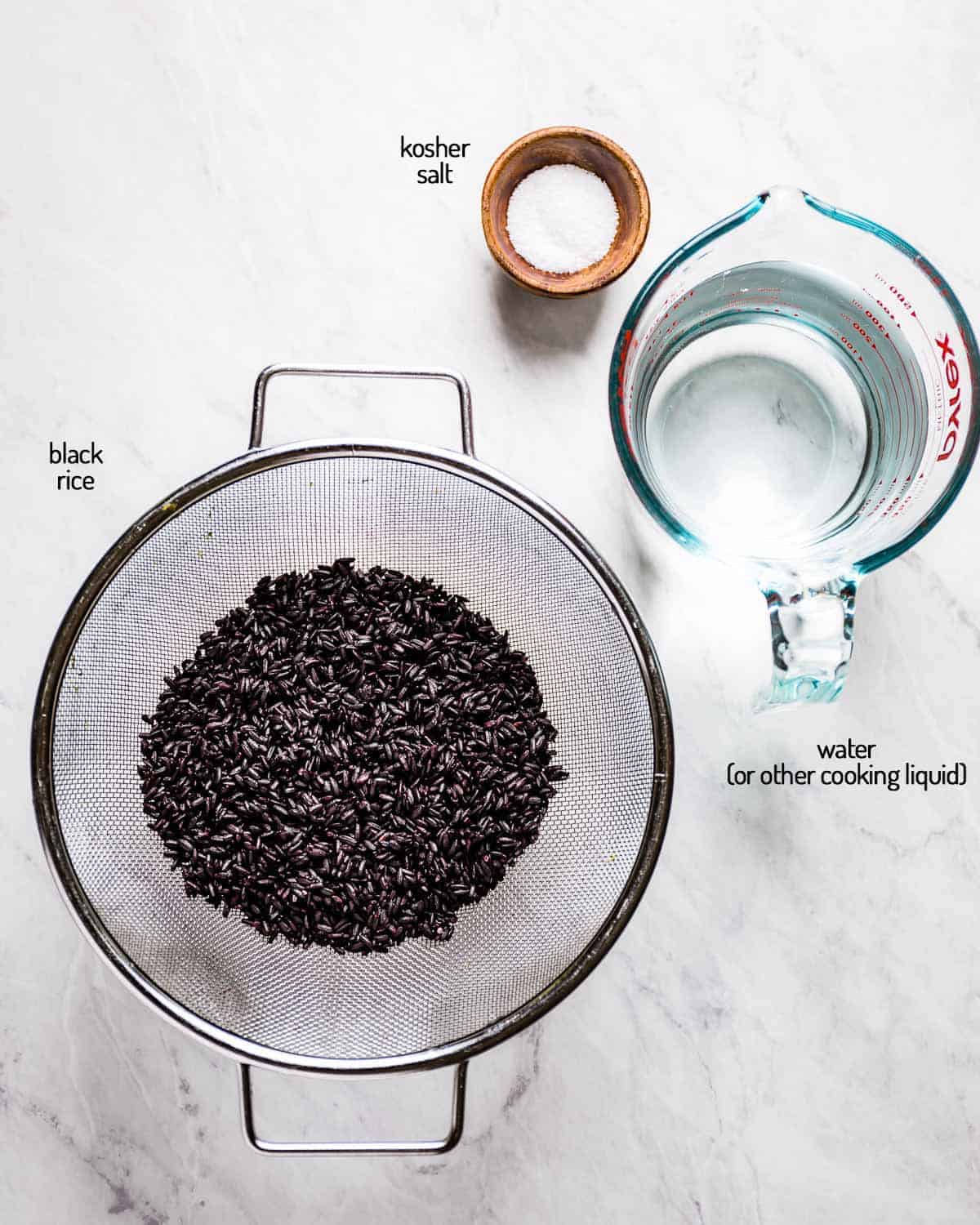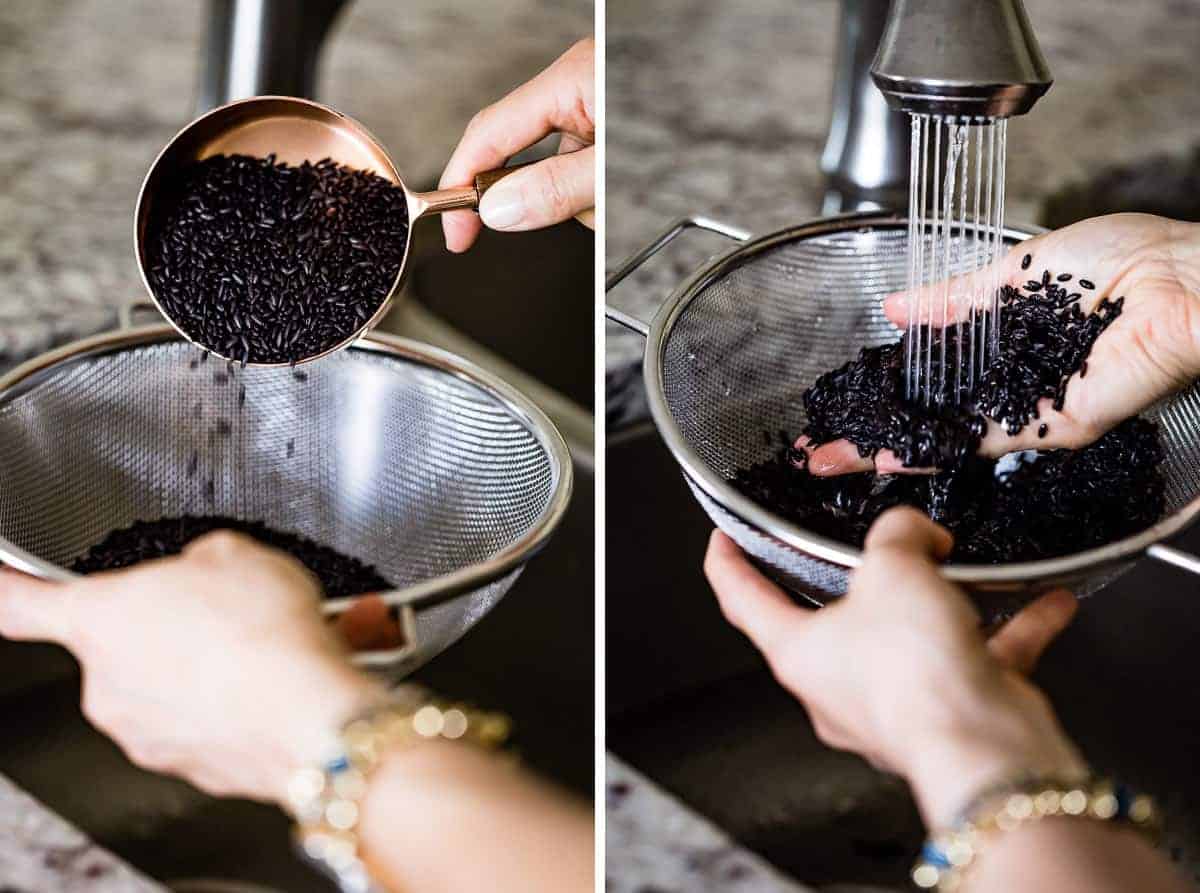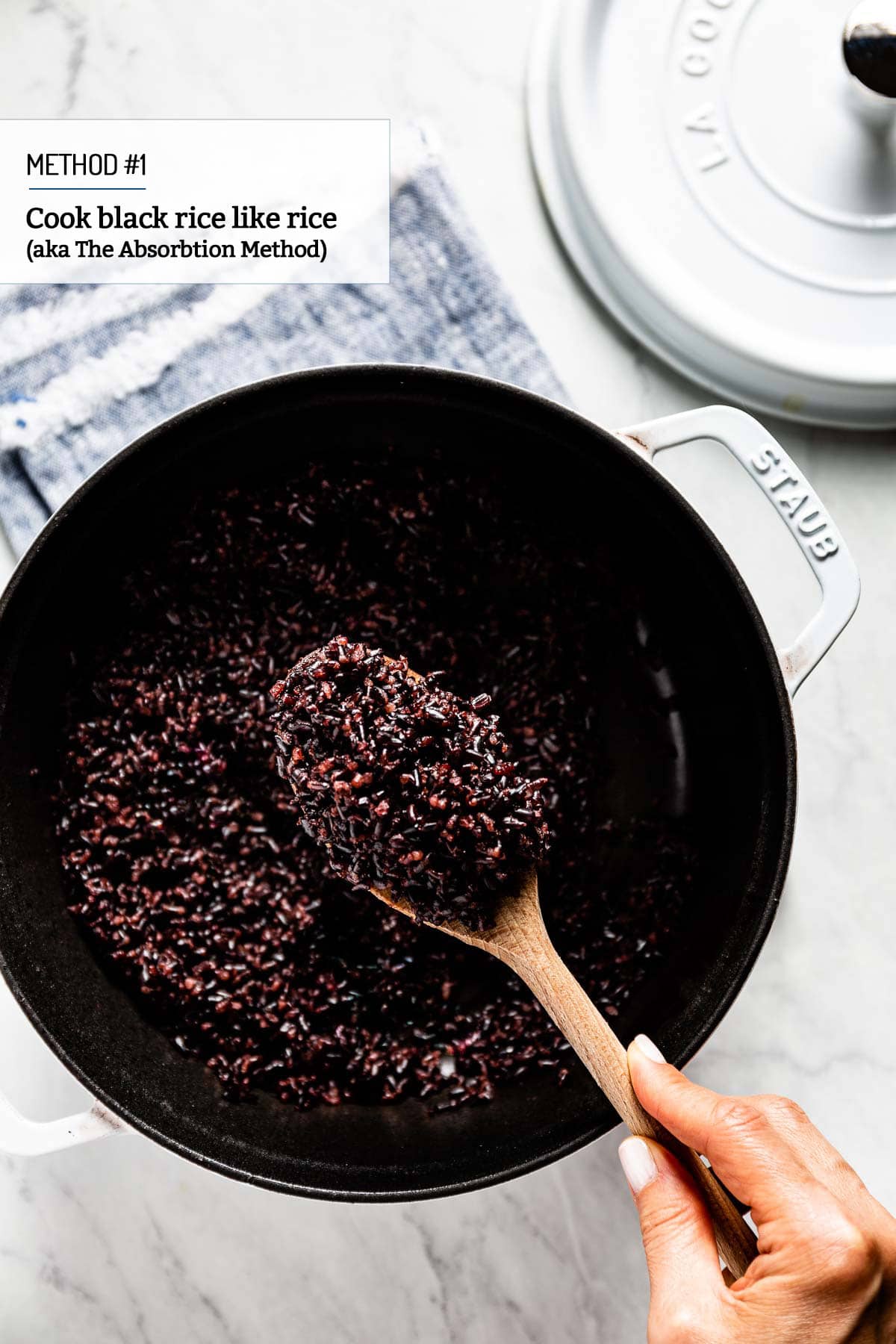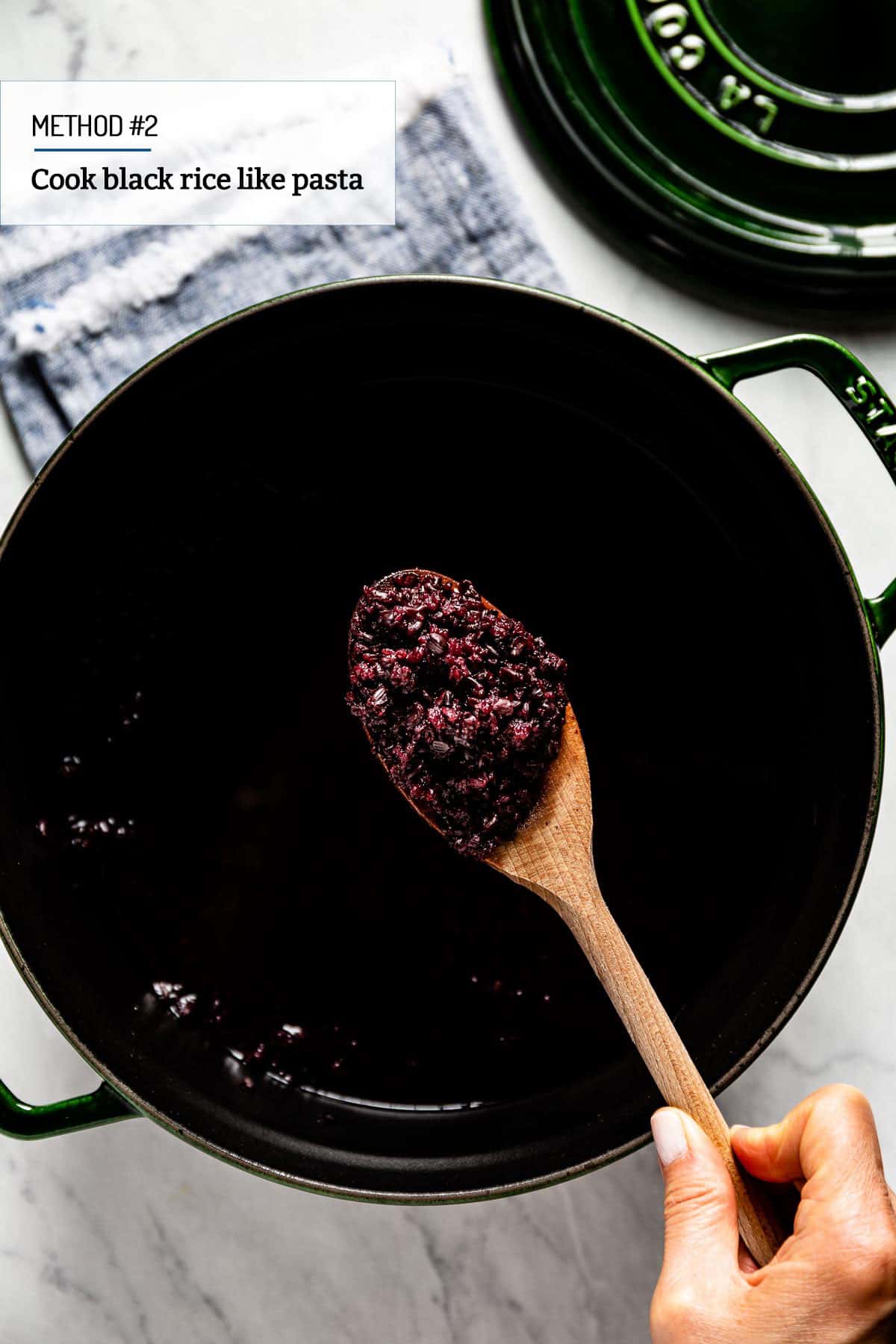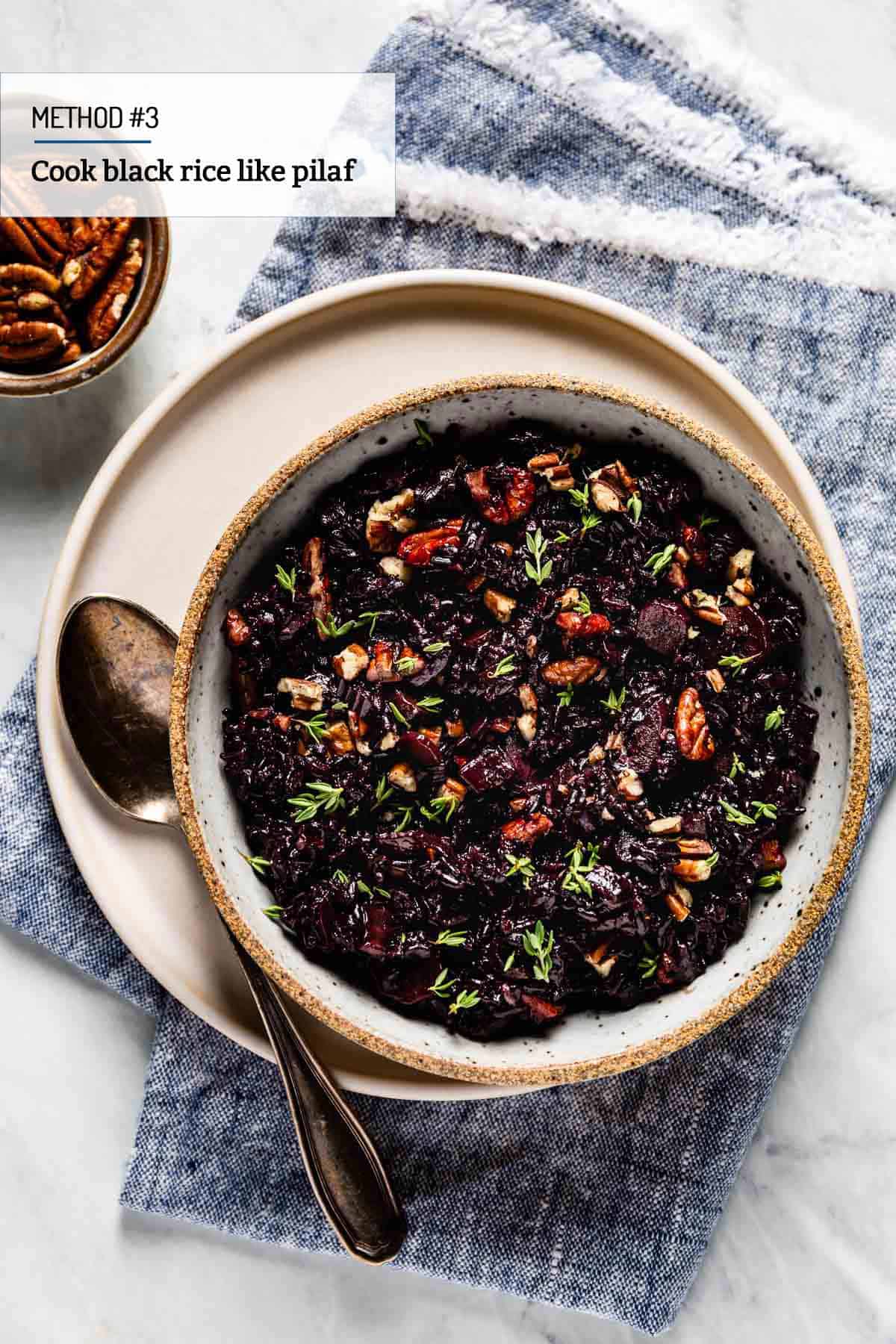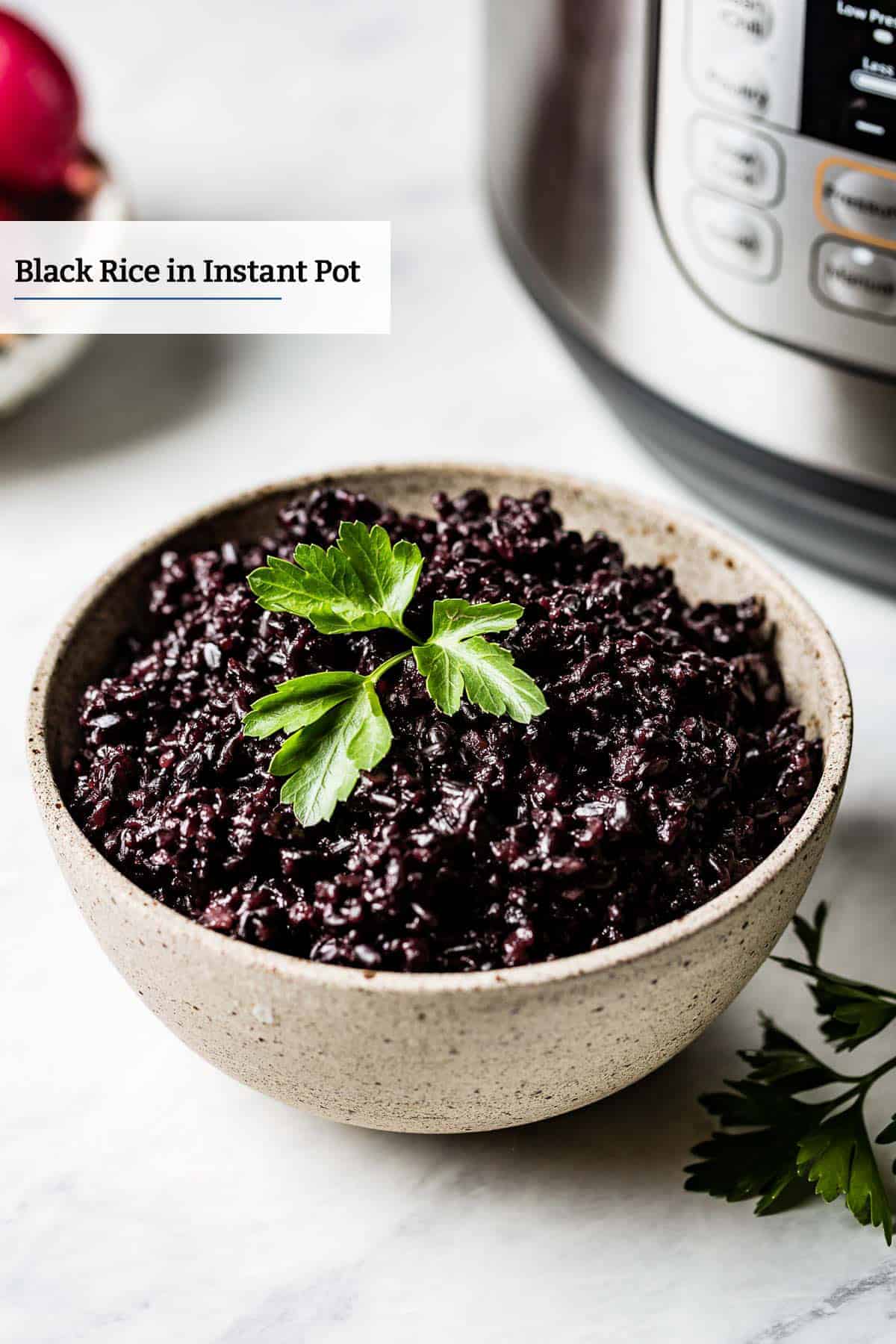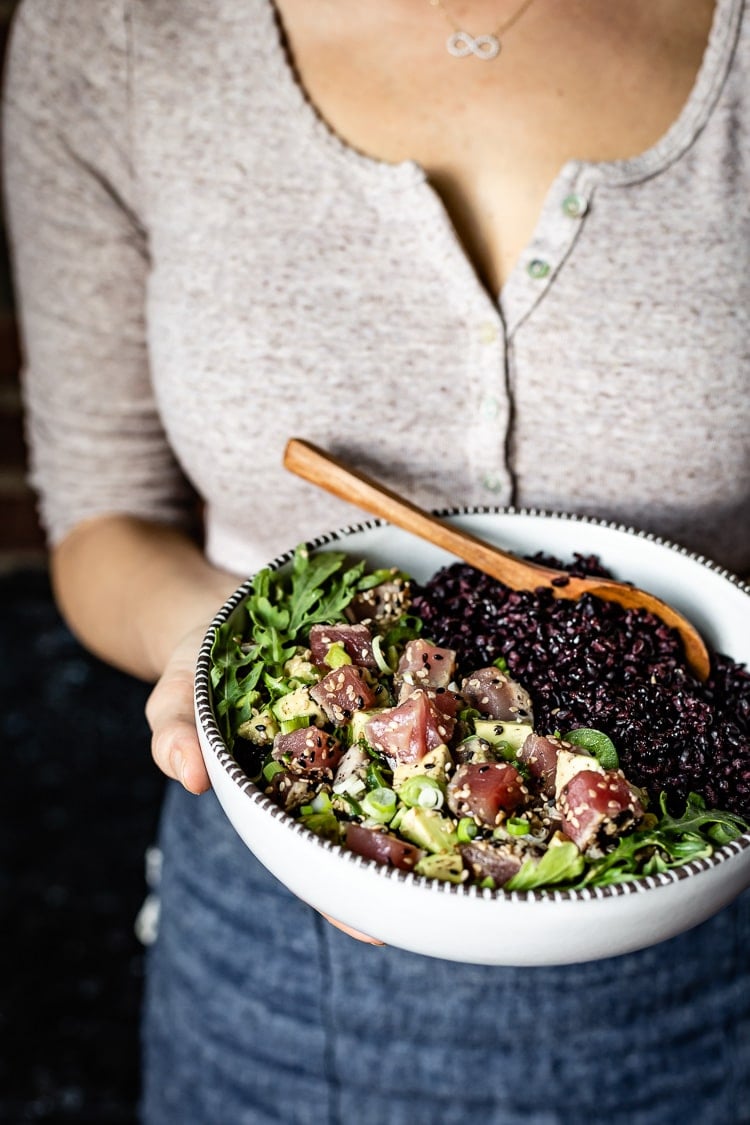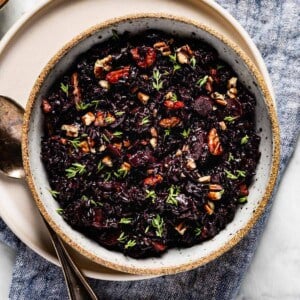If you are a fan of whole grain dishes like I am, you might also like my deep dive on cooking quinoa, bulgur, and wild rice. Black rice is also referred to as Forbidden Rice and Emperor’s Rice, because during the days of ancient China it was considered to be so nutritious that it was reserved exclusively for the royalty to ensure their longevity and health. Eventually, it became available for everyone and came to this day as a grain that is synonymous with good health and long life. Below are the three most common types of forbidden black rice, along with the most popular brands you can find:
Black Rice (Purple Rice):
This is the most common type of black rice sold in the US markets. This unmilled, medium-grain rice is grown in Zhejiang province in China. However, nowadays, it is also grown in various parts of the world. Some popular names for black rice are Forbidden rice, Heirloom Black Rice, Kavuni Rice, Purple Rice, Bolay Black Rice and Black Jasmine Rice. While there might be slight differences in production and/or brands, they are essentially the same thing. Some popular brands that sell black rice in the US markets are (affiliate links):
Black Japonica Rice™ & Black Pearl Rice by Lundberg
Black Japonica Rice™ and Black Pearl Rice are not technically black rice. They are grown in California by Lundberg Family Farms. However, because they are widely available in the US and offer a very similar taste and texture to black rice, I think it is appropriate to include them as a part of the family. Black Japonica Rice is a mixture of short-grain black rice and medium-grain mahogany rice (a type of red rice.) The name is trademarked by Lundberg Family Farms. It is marketed as “A Gourmet Field Blend of Black & Mahogany Rice” and offers a very similar nutty flavor with subtle savory and sweet notes. On the other hand, Black Pearl Rice is similar to black rice in that it is a whole grain rice with the bran intact and has a black pigment on the kernel. It is often cooked by steaming (in a bamboo steamer) and compared to Chinese Black rice, it has a more sticky texture when cooked. You can see this version also used in Korean cooking and they refer to it as Wild Sweet Rice or Black Sweet Rice. It is often used in Thai cuisine in desserts, custards, pudding, and porridge recipes often topped off with fruit and coconut. Black Thai Glutinous Rice is not as widely available in the US as the other two types of rice. However, you can find them in Asian supermarkets and specialty stores or purchase it online. While Thai Black Rice is not the same thing as Chinese Black Rice, in most recipes, you can use Chinese Black rice instead of Thai sticky rice. I am sure there are exceptions to this, especially if you are cooking authentic recipes, but I found that for basic recipes like Black Rice Salad or Black rice pudding, they can be used interchangeably. The only exception to this is when cooking it as pilaf, which we will cover in more detail below.
How To Prepare Black Rice for cooking?
Should I rinse before cooking?
The jury is out on this one. Popular websites like TheKitchn and Martha Stewart do not recommend rinsing black rice before cooking, citing that doing so might wash away its nutrients. However, some other websites suggest that rinsing is necessary to eliminate some of the excess starch that makes the rice gummy. I personally wash my black rice only if I am getting it from the bulk bins. If I am buying packaged black rice, I do not rinse it. One exception to this is if I am cooking black rice in a rice cooker as most rice cooker brands suggest rinsing rice before cooking. If you decide to wash it, measure and place it in a fine mesh strainer and rinse it under cold running water. As the water runs through the rice, you will see it turn dark purple. Be aware that this liquid will stain your clothes and your countertops so be careful not to splatter it all over the place.
Should I soak it before cooking? If so, how long?
The short answer to this question is no. However, as it is the case with most whole grains, soaking it before cooking has some benefits. The following explanation comes from one of my favorite cookbooks, My New Roots: Inspired Plant-Based Recipes for Every Season. If you decide to soak, mix 1 cup of black rice in three cups of water in a bowl and let it sit for an hour or overnight. Keep in mind that the cooking time will be shorter if you soak it. The amount of time will depend on how long you soak it. The longer it soaks the quicker it will cook. With that being said, you can cook black rice without soaking. The difference between soaked versus un-soaked black rice is going to be the time of cooking plus the benefits mentioned above. I personally do not soak black rice before cooking (because I can never remember it), and the recipes I share below are made without soaking black rice prior to cooking.
Rice Cooker Method:
Cooking Black Rice in Rice Cooker is also easy and perfect if you want a method where you can set-it-and-forget-it.
Cook it Like Rice:
This is the most popular method and the one that is recommended on the packaging of most black rice sold in the supermarket. It is also referred to as the absorption method. Water to black rice ratio for the absorption method is 2 to 1. In other words, you will need 2 cups of cooking liquid (like water, chicken stock or vegetable broth) for every cup of black rice you use. To Cook Black Rice using the absorption method:
Pros & Cons of Cooking It Like Rice:
Pros: The advantage of this method is that you can change up your cooking liquid to make it more flavorful. I also like the fact that after all of the liquid is absorbed, the rice looks and tastes perfectly cooked. Cons: The disadvantage is that you have to keep a close eye on it to ensure that there is enough liquid in it and it is not sticking to the bottom of the pan. During all of my recipe testing, in every brand that I tried, my black rice was cooked between the 30-33 minute mark using this method.
Cook it Like Pasta:
To me, this is the easiest method. I love the fact that this method provides less sticky black rice in the end (compared to the absorption method). When you are cooking black rice like pasta, there is no need to be exact about the amount of water you use. To cook black rice like pasta:
Pros & Cons of Cooking it Like Pasta:
Pros: This method of cooking is hands-off and quicker (ready after 20 minutes of simmering) than any other method.Cons: You can’t take advantage of flavoring it using chicken or vegetable stock (unless you want to waste it) and you might lose some of the nutrients after it is drained. Additionally, similar to pasta, if you leave it in the liquid after it is cooked, it will get mushy.
As a matter of fact, I took inspiration from my Wild Rice Stuffing recipe for this method of cooking. It is a great way to season black forbidden rice with vegetables, fresh herbs and spices and turn it into a delicious whole grain side dish. You can use any vegetables you have on hand, including but not limited to onion, garlic, carrot, celery, peas, and mushrooms and flavor it with fresh herbs like thyme and parsley. You can also season black rice with fresh or dried thyme, chives and salt, and black pepper. To make my basic Black Rice Pilaf recipe:
Pros and Cons of Cooking it Like Pilaf:
Pros: Cooking forbidden rice with vegetables complements its nutty texture and makes it even more flavorful. You can literally serve this dish by itself as a vegan and gluten-free meal or as a side dish with any of your dinner recipes. Plus, you can switch up the vegetables using this basic black rice pilaf recipe as a place to start.Cons: This is not a very hands-off method. You would have to keep an eye on it to make sure that it has enough water and not sticking to the bottom of the pot. Also, after it is fully cooked, all of the vegetables turn black, requiring a bit of food styling to make it look appealing to the eye. I top it off with a handful of chopped pecans (for color and crunch) and garnish it with fresh thyme (or any herbs you have on hand.)
I covered each method with everything you need to know in their respective recipe posts, but below are a quick snapshot of how to make black rice in each device.
Pressure Cooker Method:
Cooking black rice in an Instant Pot is easy and hands off. The water to rice ratio for cooking in a pressure cooker is 1 to 1. In other words, you will need 1 cup of cooking liquid (water, chicken stock or vegetable stock) for every cup of black rice. For Chinese Forbidden rice, set your Instant Pot to 17 minutes on high and let it release the pressure naturally. If you are cooking Thai Black Sticky Rice, set it to 20 minutes on high and again, let it release the pressure naturally. There is no need to grease the pressure cooker insert as it does not stick. The ratio of water to rice for cooking black heirloom rice in a rice cooker is 1 ¾ cups of cooking liquid (water, chicken stock, or vegetable broth) to 1 cup of black rice. When cooking it in a rice cooker, I recommend using a tablespoon of vegetable oil to grease the rice cooker insert because it does stick to the bottom and makes clean up difficult later on. To cook it, I set my Aroma Rice Cooker to the brown rice setting and it took about 55-60 minutes to cook.
How Long Does It Take to Cook black rice?
Each method takes a different amount of time and might slightly differ based on the brand or the type of forbidden black rice and equipment you are using.
What to Eat With Black Rice?
You can serve this black rice recipe with any of your meat, chicken and vegetarian meals as a whole grain side dish. A few of my favorites are:
The absorption method (aka cooking it like rice): 30-33 minutes of simmer time after the water comes to a boilCooking it like pasta: 20 minutes of simmer time after the water comes to a boilBlack Rice Pilaf (Cooking it with vegetables): 30 minutes of simmer time after it comes to a boilInstant Pot method: About 30-33 minutes (5 minutes for it to come to pressure, 17 minutes active cooking time and 10 minutes natural release)Rice Cooker method: About 55-60 minutes
The popular website, Healthline, says that it is one of the healthiest rice to consume (amongst all other types of rice) and outlines the benefits of black rice as:
Black rice – 100 grams – SourceCalories: 356 kcalProtein: 8.89 grams Carbohydrates: 76 grams Fiber: 2.2 gramSugar: 0 grams
Brown rice – 100 grams – SourceCalories: 357 kcalProtein: 7.14 gramsCarbohydrates: 77 gramsFiber: 2.4 gramsSugar: 0 grams
Wild rice – 100 grams – SourceCalories: 101 kcalProtein: 4 gramsCarbohydrates: 21.3 gramsFiber: 1.8 gramsSugar: 0.73 gram
Use it in salads as a grain: Adding a cup of cooked black rice in any salad recipe makes it filling and nutritious. A great example of it is my Black Rice Salad, where I use cooked rice as a base and flavor it with an Asian salad dressing. Or try this Forbidden Rice Salad with Curry Dressing.Black Rice Cereal/Porridge or Black Rice Pudding: Serve it for breakfast by simply pouring hot or cold almond milk (or coconut milk) over it and topping it off with nuts and fruit.
Use it as a base for your grain bowls: I serve my Sesame Seared Tuna Salad over black rice, which turns it into a filling meal. You can also swap quinoa with black rice in my Sweet Potato Quinoa Bowl.Add a cup of black rice into soups and stews: You can add it to any soup or stew recipe that uses pasta/orzo, or quinoa as a filling.
Ground Turkey MeatloafPot RoastCornish HenWhole Roasted ChickenWith vegetable dishes like Baked Asparagus, Roasted Delicata Squash, and Whole Roasted Carrots
Expert Tips for Success:
Black Rice Stains: When cooking black rice keep in mind that it stains clothes, cooking utensils, and even countertops. So, be careful when handling it.It is best to use a heavy bottom pot with a tight fitting lid: While you can use any pot to cook black rice, if you have it, I recommend using a Dutch oven with a tight lid and preferably with a dark interior when cooking black rice. Doing so will help cook it evenly and hide the black stains. I use my 4 quart round Staub Dutch Oven (affiliate link.)Every brand is different: I have tested these recipes several times using each method with all the brands I mentioned at the beginning of this post. Please keep in mind that the cook time might slightly vary depending on the brand and method of cooking you are using. Please use my recipes and recommendations as a place to start and adjust accordingly based on the brand and method you are using.
The first time I published this Forbidden Rice Recipe was back in May of 2016. Since then it has been a favorite in our house. Today, Jan 2023, I am updating that old post with some new photos and additional helpful information.
